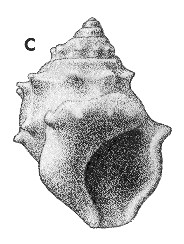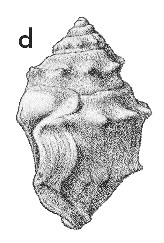
Revised descriptions of New Zealand Cenozoic Mollusca from Beu and Maxwell (1990)

 | Revised descriptions of New Zealand Cenozoic Mollusca from Beu and Maxwell (1990) | 
|
  (Pl. 20c): GS14484, K34/f9510, "Struthiolaria beds", Porter River, Castle Hill Basin, Canterbury, Altonian (GNS) |
  (Pl. 20d): GS14484, K34/f9510, "Struthiolaria beds", Porter River, Castle Hill Basin, Canterbury, Altonian (GNS) |
Beu & Maxwell (1990): Chapter 11; p. 190; pl. 20 c,d.
Synonymy: S. tuberculata Hutton 1873b, p. 11; S. spinosa Hutton 1886a, p. 335 (not of Hector, 1886)
Classification: Struthiolariidae
Description: Rather small for genus freight typically 35-40 mm but up to 50 mm). Protoconch not known. Teleoconch whorls with a pronounced subsutural fold, producing a relatively narrow, strongly concave sutural ramp, about 5-7 whorls on adult shells; peribasal angulation on last whorl typically projecting more strongly than shoulder angulation, area between angles almost flat. Spiral sculpture preserved on only a few unworn specimens, of fine threads; axial sculpture of prominent, sharp tubercles on shoulder angle and somewhat weaker ones, not corresponding in number or position to those above, on lower angulation; 10-12 shoulder tubercles on both penultimate and last whorls. Aperture moderately heavily callused; inner lip callus thickest near middle where it forms a tongue-shaped projection on some shells; parietal callus spreading above peribasal angulation, in some shells extending almost to shoulder angle. Outer lip with a broad, flat, rather low varix and a narrow but relatively deep posterior notch.
Comparison: Struthiolaria spinifera (Otaian or Altonian, Mt Harris) resembles S. tuberculata in sculpture and in having the peribasal angulation projecting more than the shoulder angle, but the holotype is considerably larger (height 60 mm) than the largest specimen of S. tuberculata, has a much less pronounced subsutural fold, and lacks the distinctive posterior notch in the outer lip. S. spinifera is known definitely only by the holotype and although it may be represented by very rare shells from Sutherlands and Ardgowan Shellbed, it is too poorly understood to tell whether it is a recognisable species. The "Struthiolaria beds" in the Castle Hill Basin are of very shallow-water, probably estuarine, facies whereas the Mount Harris Formation is a deeper-water, probably mid- or outer shelf deposit, suggesting that distinct species should be expected in these formations. S. tuberculata is effectively distinguished from other species by its relatively small size, short shape, prominent subsutural fold, strongly tubercular sculpture, projecting peribasal angulation and distinct posterior notch.
Distribution: Altonian, "Broken River" (type—probably from Enys Formation, Porter River, Castle Hill Basin, between the limestone gorges, or from Whitewater Creek) (common at both localities). Not definitely recorded away from Castle Hill Basin.
Cite this publication as: "A.G. Beu and J.I. Raine (2009). Revised
descriptions of New Zealand Cenozoic Mollusca from Beu and Maxwell (1990). GNS
Science miscellaneous series no. 27."
© GNS Science, 2009
ISBN
978-0-478-19705-1
ISSN 1177-2441
(Included with a PDF facsimile file
copy of New Zealand Geological Survey Paleontological Bulletin 58 in CD version
from: Publications Officer, GNS Science, P.O. Box 30368 Lower Hutt, New
Zealand)